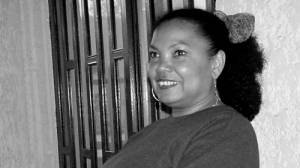María Teresa Trombetta is an artist who has
outstanding skills in the different techinques to handle glass as a means of
expression. She has explored, researched, and sought the plastic
possibilities of glass and has been able to obtain different and excellent
results. Her mastery skills have given her a relevant position in this
discipline.
She began her career studying arts, and her first
works recreate seaside views in which the beach, sand, rocks and fishing boats
are the main subject. Later, she works drawing in agricultural
publications - an activity that will increase her interest in wildlife.
During those days, a deep concern on sea life begins to show in the artist's
life; a concern that will be deeply rooted when she writes the story "Death
travels on a fishing boat." In this story, she describes the
devastation and destruction left by the tourists that visit Venezuelan beaches.
It shows her concern, alarm and sorrow in her interest to save nature.
This is how she begins to define an issue that remains unchangeable throughout
her professional career.
In time, Trombetta makes a speech out of images
and shapes that reminds us of the complex spectrum of the sea world, retelling
us particular stories that go beyond her regional background to deal with what
is universal. In the series Sea anemones, Hedgehogs, and other sea
creatures, her underwater experiences when scubadiving shape these images -
which, represented in glass and iron, make up strong and expressive objects
that make us face life underwater.
Later, her issues evolve and become a narration
that, when we are faced to the trace, imprint and ruins left by mankind in its
passing through nature, produce in us all kinds of feelings: Life/death, loss,
devastation, destruction, desolation are the consequences of progress.
Her series "Cayo Sombrero", "Cayo Sur", "Deep sea
fishing" and "Canned food", represent a painful, metaphoric
journey through the "Dead bodies at the beach" or the "Dead-bodies
beach" - decris and memoirs of this annihilation.
Nelly Barbieri

Basically, my work expresses a personal recreation
of the sea, its fauna and its shapes. Through my work I make an appeal
to the public to help preserve the sea. In my work I represent the
aggression the sea suffers because of mankind and progress.
Criogenia or not everything can be cloned...
as uselessly protected from extintion, to be
reproduced in the future as "improved species", there lay in the
coldness of the laboratory, to the availability of the consumers, the
specimens...all bottled up and coded...
María Teresa Trombetta
Home
- C
V - Gallery
- Guestbook
- links
-
Contact me

